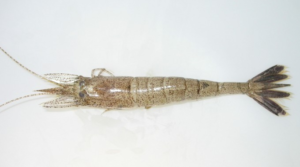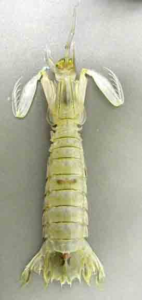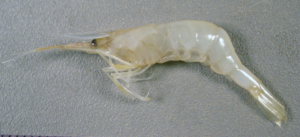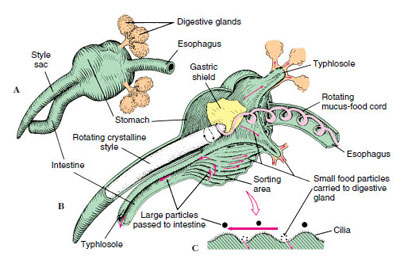
Several species of Shrimp can be found in and around Barnegat Bay
Shrimp in Barnegat Bay
Shrimp are swimming crustaceans found widely around the world in both fresh and salt water.
They are decapods having ten legs like crabs and lobsters.
Grass Shrimp Palaemonetes spp
Grass shrimp are the most common species of shrimp inhabiting Barnegat Bay.
Several species of grass shrimp that can be found in the bay are so similar in appearance that it requires extremely close examination to accurately identify the species.
Examples are:
– Common shore shrimp Palaemonetes vulgaris
– Daggerblade grass shrimp Palaemonetes pugio
– Brackish grass shrimp Palaemonetes intermedius
Grass shrimp are the most common species of shrimp inhabiting Barnegat Bay shallow coastal waters from Cape Cod south. They are commonly found in salt marshes, seaweed, and eelgrass beds along the coast. Using well-developed sense organs, grass shrimp can easily maneuver and swim in the water, but they are found most frequently crawling along the bottom. Like other crustaceans, grass shrimp can cast off legs and regenerate new ones. They grow by molting, shedding their exoskeletons and forming new, larger coverings. Between molts, a grass shrimp will eat almost anything, including its own exoskeleton. Grass shrimp are omnivores and feed on a range of plants and animals, including detritus, phytoplankton, and other small invertebrates.
Fun Fact – The abbreviation “sp.” is used when an actual specific species name cannot or need not be specified. The abbreviation “spp.” (plural) indicates “several species”
Sand Shrimp Crangon septemspinosa
 The sand shrimp is a small species of shrimp common to estuaries along the Atlantic coast.
The sand shrimp is a small species of shrimp common to estuaries along the Atlantic coast.
It has a stout, heavy body that tapers to a narrow tail.
Similar in appearance to the grass shrimp, sand shrimp can be identified by a few key characteristics.
The sand shrimp is flattened from top to bottom, rather than from side to side as is in the grass shrimp.
Sand shrimp have only one pair of claws, which are shaped more like hooks than typical snapping claws. The rostrum (a spiny projection between the eyes of many shrimp), is short on this species.
Sand shrimp feed on benthic invertebrates, organic detritus, and even larval and juvenile fish. They are preyed upon by bottom-dwelling fish, comb jellies, and skates, and are subject to cannibalism by their own species
These shrimp can be observed in the nearshore salt marsh communities living in similar habitat to that of the grass shrimp. In the summer they are found in shallow waters, while in the winter they move into deeper waters. In the spring they migrate back into the shallow, warm estuarine waters. This shrimp is inactive during the day, burrowing in the sediment with only antennae exposed. They remain burrowed throughout daylight hours but will emerge if the sediment is disturbed. At night they are active in the benthic community, foraging for food.
Mantis Shrimp Squilla empusa
 Mantis shrimp are crustaceans with elongated bodies and specialized body structures.
Mantis shrimp are crustaceans with elongated bodies and specialized body structures.
They are distantly related to crabs, lobsters, and shrimp.
Their front limbs are the most specialized, and some species use them as weapons.
In these species, the limbs become calcified which allows the shrimp use them like a club.
swimming crustaceans found widely around the world in both fresh and salt water. They are decapods and like crabs, they have ten legs.
Mantis shrimp excavate and occupy a burrow in soft sediment from which it emerges, mainly at night, to feed on fish and invertebrate prey.
Ses


